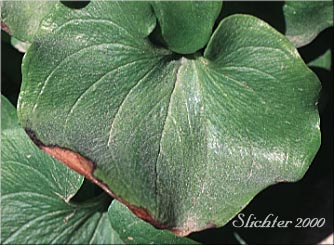 Photo
at right of a leaf of fringed grass-of-Parnassus from along the Lostine River,
near the Eagle Cap Wilderness.......July 26, 1997.
Photo
at right of a leaf of fringed grass-of-Parnassus from along the Lostine River,
near the Eagle Cap Wilderness.......July 26, 1997.
Also known as Rocky Mt. grass-of-Parnassus, fringed grass-of-Parnassus is an attractive perennial wildflower with single or clustered stems from 10-30 cm high arising from a cluster of basal leaves atop elongated rhizomes. The herbage of both the stems and leaves is glabrous. A heart-shape bract from 4-20 mm long may be found clasping the stem near to above midstem. The blades of the basal leaves are heart- or kidney-shaped and measure 1.3-4 cm long and 2-4 cm wide. The leaf blades are slightly longer than wide. The petioles are 3-9 cm long.
The white flowers are solitary at the top of the stems. The petiole is 6.5-12 mm long while each of the 5 sepals is lanceolate with obtuse to rounded tips, each measuring 4-6 mm long. Each sepal may be entire or somewhat fringed or thinly toothed along the lower third of the margin. Each of the 5 oblanceolate to obovate petals are 6.5-12 mm long, 2.5-7 mm wide, and each has 5-7 veins. The margins of the lower half of the petals are covered with numerous thick and tangled white hairs from 1-3 mm long. Five fertile stamens are found spreading between the petals. The filaments of fertile stamens are 4.5-7 mm long and white in color. The yellow anthers are 1.5-2.5 mm long and attached at the middle of their ventral surface. In addition, the flowers have sterile stamens (known as staminoda) which look like thick greenish-yellow disks with 5-8 blunt lobes, each with a rounded disk found at the petal bases. The styles, which are very short or almost absent, are divided into 4 styles up to 4 mm long.
Fringed grass-of-parnassus may be found in marshes, bogs, wet meadows and along streams from 1900-3350 meters of elevation in the lower mountains up to the alpine zone.
Fringed grass-of-parnassus may be found from Alaska south to the Sierra Nevada of northern California and east to the Yukon and western Alberta, and south in the Rockies to Utah, Nevada, and New Mexico.